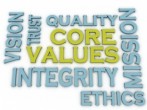 We often hear and talk about corporate culture but what is it practically ? What is it made of ? How does it influence the functioning of a company and how can it be changed ?
We often hear and talk about corporate culture but what is it practically ? What is it made of ? How does it influence the functioning of a company and how can it be changed ?
One way to attempt to answer these questions is to look at it from the angle of what is explicit/conscious versus what is implicit/unconscious.
The conscious part is made of advertised company values, they are explicitly shared (human resources, management, web sites, presentation, poster campaign, …) and consequently managed and controlled. On the other hand the unconscious part is made of implicit values and beliefs (sometimes limiting) which are unmanaged by nature and consequently unconsciously propagated and perpetuated. But how ? and what are the main enablers ?
The top and middle management have the most influence and responsibilities in propagating conscious and unconscious culture (good or bad). Employees lower in the organisation hierarchy often have no choice but to comply i.e. accept or leave. But behavioural programming is also a key element: employees mindset is shaped by the “environment” and they also consequently perpetuate its implicit rules, values, habits and unwritten traditions unconsciously. The “system” is self-perpetuating.
This can only be changed by first recognising the substantial impact these implicit or unconscious aspects have on the enterprise functioning and this is most probably the hardest part because a crisis or extreme difficulties are often necessary to start to envisage that causes are of this nature. It is often after having attempted more classical approaches like re-organisation, drastic cost cuts, rationalisation initiatives that a ‘soft controls’ approach is finally envisaged (rarely though). So corrective actions are not only taken in a reactive manner but the true root causes may ultimately not be addressed at all.
If a ‘soft control’ [1] approach is finally adopted, it is then necessary to identify the specific unconscious aspects of the company, its “signature” in a way. This signature has its upsides we would like to keep but unfortunately it has also its downsides we ideally want to get rid of. Here are a couple of examples:
- Fear
- Lack of active listening
- Urgency to react (all mighty time pressure)
- Interactions considered as parasitizing (no collaboration, job protection)
- Type of initial reaction to challenges:
- Intellectual (risk of analysis/paralysis paradigm [2])
- Energetic (risk to miss the target by lack of focus)
- Seek help (risk of stagnation)
These unwanted aspects and behaviours typically lead to :
- Two levels of functioning: official and implicit, which one is predominant ?
- Disengagement
- Increased risks, costs, delay
- Waste of resources
- Decreased quality
- Deterrent to change
It is absolutely crucial to detect when these aspects come into play and to react by applying the appropriate actions. This can be achieved through various means like projects post mortem, audit and control, behavioural analysis, coaching but more importantly by accompanying employees and all management levels in the elaboration of the best actionable corrective steps.
Conclusion
The corporate culture is a key parameter to an efficient and effective enterprise management and not an accessory topic to be left to the only attention of the Human Resources department:
“The corporate culture is the most powerful control in any organisation”
- James Roth, author of “Best practices : evaluating the corporate culture”
References & related topics
[1] What are soft controls ?
[2] Analysis-paralysis, wikipedia
[3] Anti-pattern, wikipedia
[4] Organizational culture, wikipedia
[5] The role of metacognition in human social interactions
[6] The Power of Norms and Groups on Individuals

Leave a Reply
You must be logged in to post a comment.